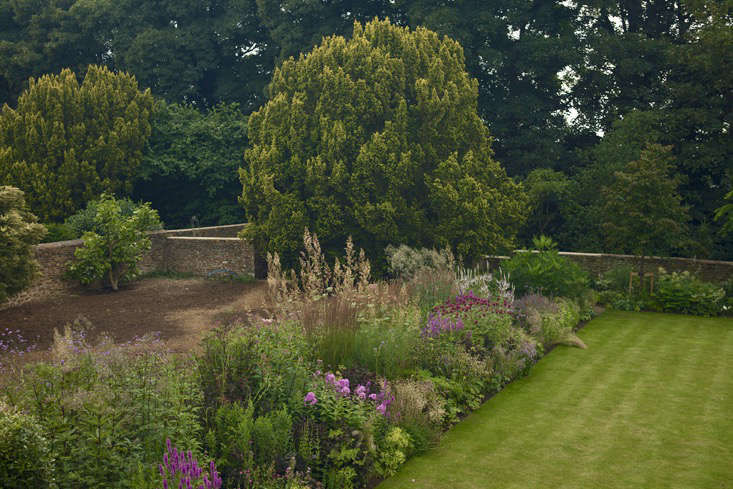
Luke and Petra Hoyer Millar are unusual people; they moved to their current address in Oxfordshire two years ago but though they love their house, they’ve ignored it.
Photography by Jim Powell for Gardenista, except where noted.
What do you wish someone had told you in the beginning?
“The cost of dry stone walling,” says Luke. The Hoyer Millars’ property at the back of the house consists of two main gardens enclosed by dry-stone walls.
Almost all of of the stone walls had to be replaced. Previous owners had covered them with chicken wire, to encourage the ivy that led to their destruction, while allowing hazels to dig in as well.
What do you love most about the garden?
The main garden from the terrace, which is set on a lower level.
How does the view from the windows look in all four seasons?
Grasses such as Calamagrostis x acutiflora ‘Karl Foerster’ overwinter well. The garden is on show all year round, which can be a challenge.
Sighs of relief from this rejuvenated garden are almost audible as Petra Hoyer Millar shows us around. On the other side, she and Luke fast-forwarded the woodland garden by planting mature hornbeam and hazel.
How did you deal with pre-existing trees?
Oversized trees by the dry stone wall at the back of the garden were replaced by more choice specimens such as this Parrotia persica.
Petra and Luke increased an east-facing border border, from 3 feet to 10 feet deep. There is now room for globes of alliums, with seedheads of Allium christophii and purpurea shown here, as well as colonies of Allium sphaerocephalon.
Did you change the size or layout of garden beds?
A footpath of irregularly laid pavers winds through a newly created area of garden which was previously unusable, since it was overrun with outgrown shrubs. The solid, newly restored wall is a tempting place to perch.
What hardscape elements did you add?
On the other side of the back wall a woodland garden was created, adjacent to a footpath by the castle. ‘Wulfenii’, moved from another part of the garden.
What did you discover about irrigation?
“We had no taps, except two by the house; there were none around the garden,” says Petra.
“As every gardener learns, it takes a lot longer than you think it will,” says Petra. She’s repeated sambucus around the garden since she liked the one that was here before.
What’s surprised you most as the garden has matured?
Budding Sambucus Nigra.
Photograph by Petra Hoyer Millar.
On one side of the lawn it is 3′ tall which is normal for me, but it has grown to 6 feet on the side that faces west,” says Petra.
What grew in a different way than expected?
Photograph by Petra Hoyer Millar.
Monarda ‘Raspberry Wine’ flanked by Lythrum salicaria.
A mysterious pink phlox, thought to be ‘Sandringham’, which has been joined by more phloxes in less subtle shades, a California tree poppy, which interrupts the flow with its white flowers but has lovely glaucous foliage.
What did you keep from the previous garden?
Photograph by Petra Hoyer Millar.
Phlox ‘Sandringham’ (probably). Ageritina altissima ‘Chocolate’ is the updated name and it is smaller than most, growing to about 4′ and flowering much later, in October.
How did the habits of previous owners affect the layout?
Sanguisorba officinalis between the terrace and garden. Garden refuse reached almost to the top of the 10-foot wall.
The white coolness of the back border meets the general theme of purple and pink, separated by a path to the side door in the wall.
How do you use your outdoor space in ways you didn’t before?